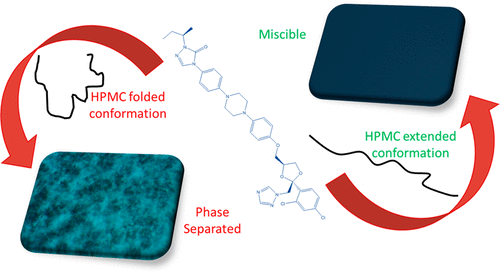当前位置:
X-MOL 学术
›
Mol. Pharmaceutics
›
论文详情
Our official English website, www.x-mol.net, welcomes your feedback! (Note: you will need to create a separate account there.)
Phase Behavior of Drug-Hydroxypropyl Methylcellulose Amorphous Solid Dispersions Produced from Various Solvent Systems: Mechanistic Understanding of the Role of Polymer using Experimental and Theoretical Methods
Molecular Pharmaceutics ( IF 4.9 ) Pub Date : 2018-06-06 00:00:00 , DOI: 10.1021/acs.molpharmaceut.8b00324 Naila A. Mugheirbi 1 , Laura I. Mosquera-Giraldo 1 , Carlos H. Borca 2 , Lyudmila V. Slipchenko 2 , Lynne S. Taylor 1
Molecular Pharmaceutics ( IF 4.9 ) Pub Date : 2018-06-06 00:00:00 , DOI: 10.1021/acs.molpharmaceut.8b00324 Naila A. Mugheirbi 1 , Laura I. Mosquera-Giraldo 1 , Carlos H. Borca 2 , Lyudmila V. Slipchenko 2 , Lynne S. Taylor 1
Affiliation

|
The vast majority of studies evaluating amorphous solid dispersions (ASDs) utilize solvent evaporation techniques as the preparation method. However, the impact of the solvent/cosolvent system properties on the polymer conformation and the phase behavior of the resultant drug/polymer blends is poorly understood. Herein, we investigate the influence of solvent properties on the phase behavior of ASDs containing itraconazole (ITZ) and hydroxypropylmethyl cellulose (HPMC) prepared using spin coating from binary/ternary cosolvent systems containing alkyl alcohols, dichloromethane (DCM), and water. The compatibility of the polymer with the cosolvent system was probed using high-resolution imaging techniques supported by molecular dynamics simulations. Solvent evaporation and evaporation rate profiles were tracked gravimetrically to understand the impact of the solvent composition on the evaporation process. Short-chain alcohols, including methanol (MeOH) and ethanol (EtOH), were found to induce drug-polymer demixing in the presence of water, with EtOH being less sensitive to moisture than MeOH owing to its ability to form an azeotrope with water. In contrast, water-induced mixing was observed when higher alcohols, including n-propanol (PrOH) and n-butanol (BuOH), were used as a cosolvent, due to the improved solubility of HPMC in the higher alcohols in the presence of water. Isopropanol (IPA) produced phase separated ASDs under wet and dry conditions with an increase in miscibility with faster evaporation rates in the presence of water. This solvent-triggered phase behavior highlights the importance of conducting a thorough screening of various solvents prior to the preparation of ASDs via solvent evaporation approaches such as spray drying.
中文翻译:

从各种溶剂系统产生的药物-羟丙基甲基纤维素无定形固体分散体的相行为:使用实验和理论方法对聚合物作用的机理的了解
评估无定形固体分散体(ASD)的绝大多数研究都采用溶剂蒸发技术作为制备方法。然而,人们对溶剂/助溶剂系统性能对聚合物构象和所得药物/聚合物共混物的相行为的影响知之甚少。本文中,我们研究了溶剂性能对包含伊曲康唑(ITZ)和羟丙基甲基纤维素(HPMC)的ASD的相行为的影响,该ASD使用旋涂法从含有烷基醇,二氯甲烷(DCM)和水的二元/三元共溶剂体系中制备。使用分子动力学模拟支持的高分辨率成像技术探讨了聚合物与助溶剂系统的相容性。用重量分析法跟踪溶剂的蒸发和蒸发速率曲线,以了解溶剂组成对蒸发过程的影响。发现短链醇,包括甲醇(MeOH)和乙醇(EtOH),在水的存在下会引起药物-聚合物的混合,由于EtOH与水形成恒沸物的能力,其对水分的敏感性不如MeOH。相反,当高级醇(包括正丙醇(PrOH中)和正丁醇(BuOH中),使用了作为共溶剂,由于HPMC的在水的存在下的高级醇的改善的溶解度。异丙醇(IPA)在潮湿和干燥条件下产生相分离的ASD,在水存在下,相溶性增加,蒸发速度更快。这种由溶剂触发的相行为突显了在通过溶剂蒸发方法(如喷雾干燥)制备ASD之前,对各种溶剂进行彻底筛选的重要性。
更新日期:2018-06-06
中文翻译:

从各种溶剂系统产生的药物-羟丙基甲基纤维素无定形固体分散体的相行为:使用实验和理论方法对聚合物作用的机理的了解
评估无定形固体分散体(ASD)的绝大多数研究都采用溶剂蒸发技术作为制备方法。然而,人们对溶剂/助溶剂系统性能对聚合物构象和所得药物/聚合物共混物的相行为的影响知之甚少。本文中,我们研究了溶剂性能对包含伊曲康唑(ITZ)和羟丙基甲基纤维素(HPMC)的ASD的相行为的影响,该ASD使用旋涂法从含有烷基醇,二氯甲烷(DCM)和水的二元/三元共溶剂体系中制备。使用分子动力学模拟支持的高分辨率成像技术探讨了聚合物与助溶剂系统的相容性。用重量分析法跟踪溶剂的蒸发和蒸发速率曲线,以了解溶剂组成对蒸发过程的影响。发现短链醇,包括甲醇(MeOH)和乙醇(EtOH),在水的存在下会引起药物-聚合物的混合,由于EtOH与水形成恒沸物的能力,其对水分的敏感性不如MeOH。相反,当高级醇(包括正丙醇(PrOH中)和正丁醇(BuOH中),使用了作为共溶剂,由于HPMC的在水的存在下的高级醇的改善的溶解度。异丙醇(IPA)在潮湿和干燥条件下产生相分离的ASD,在水存在下,相溶性增加,蒸发速度更快。这种由溶剂触发的相行为突显了在通过溶剂蒸发方法(如喷雾干燥)制备ASD之前,对各种溶剂进行彻底筛选的重要性。



























 京公网安备 11010802027423号
京公网安备 11010802027423号